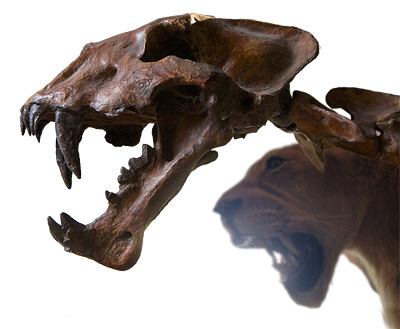Perhaps the most popular icon of the Ice Age is the sabre tooth cat (Smilodon fatalis); but this predator is only known from more southerly parts of North America, ranging no further north than southern Alberta. The more widely distributed scimitar cat (Homotherium serum) is perhaps a more fitting iconic predator of the ice age world. The scimitar cat is often confused with its sabre-toothed relative, but the two can be most easily distinguished by the size and shape of their oversized canine teeth. The scimitar cat has smaller, serrated "dirk-shaped" upper canines while it's sabre-toothed relative has larger "sabre-shaped" upper canines. Both cats would have been formidable hunters, but to date only scimitar cat remains have ever been found in Yukon.

Scimitar and sabre tooth cats are part of a unique and now extinct branch of the feline family tree, a fact only recently confirmed using DNA extracted from a Yukon fossil. Since these cats have no living relatives, palaeontologists have been struggling to unravel the mysteries of how they lived, how they used their oversized canine teeth, and why there are no scimitar or sabre-toothed cats alive today.
American scimitar cats had long limbs, a long powerful neck, a short stocky body with a sloping back, and a relatively short tail. They seem well adapted to short bursts of speed and for delivering a precise, fatal bite with their fierce upper canine teeth. However, with its specialized, precision hunting style focused on medium-sized prey (for example horse, bison and caribou), the scimitar cat appears to have been unable to compete when prey populations changed and new, less specialized predators arrived.
Scimitar Cats in Yukon
The scimitar cat was the second largest feline species to live in Yukon during the Ice Age (after the Beringian lion) — weighing in around 200 kilograms. Their meagre fossil record indicated they were relatively rare, and their populations peaked just before 20,000 years ago.
The first scimitar cat fossil ever discovered in Yukon was found in 1968. This bone, a fragment of a lower jaw, was recovered by researchers working along the Old Crow River in northern Yukon. Since this discovery, scimitar cat bones have also been found in the Klondike goldfields area and in Alaska.
Using the chemical composition of and radiocarbon dates for scimitar cat and other predator bones from Fairbanks, Alaska, researchers have been able to explore the predator-prey relationships of ice age Beringia. For example, the scimitar cat fossils from Fairbanks were all about 35,000 years old, from a time when there were few Beringian lions or short-faced bears. These scimitar cats preyed upon horses and bison, the most abundant prey animals of that time. When horse and bison numbers started to decline, and lions and short-faced bears became more abundant, the scimitar cat was outcompeted and disappeared.

Museum of Nature.
Recent Discoveries
Many researchers have attempted to answer the age-old question of why these cats have oversized canine teeth. Recent studies have looked at the relationship between the size of these impressive upper canines and overall body size to reveal information about their evolution. One striking conclusion suggests that the oversized sabre tooth cat canines may not have even been adaptations for hunting. Rather, these formidable teeth may be more related to impressing a female — something biologists call sexual selection. This contrasts with those of scimitar cats and modern felines where canines evolved as specialized hunting weapons.
Want to keep exploring? Check out the Beringian Research Notes on the scimitar cat.


